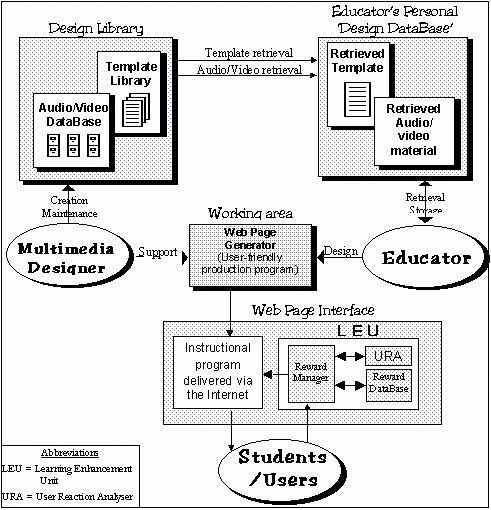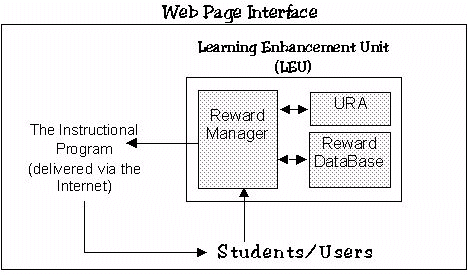An interactive analysis and feedback module designed for use with distance education and online learning
Vicki Jones and Jun H. JoSchool of Information Technology
Griffith University

An interactive analysis and feedback module designed for use with distance education and online learningVicki Jones and Jun H. JoSchool of Information Technology Griffith University |  |
One of the major limitations of many of the current electronic learning environments is the lack of interaction for the students. Our research is aimed at addressing this problem and it is for this reason that a template-based authoring system has been developed for educators who want to produce Internet-based learning (IBL) programs. This paper will discuss an interactive analysis and feedback module designed for use with distance education and online learning. The module was designed as part of a larger system, the template-based authoring system, which was developed to enable the educators themselves to design and create their own educational web pages to suit their students' requirements.
The need to make education more effective in regard to time, effort and money, and to still deliver good quality, provided a suitable climate for the development of distance education and online courses. For mature-age and part-time students, these courses offer considerable advantages which include convenience and flexibility. However, there are limitations. The major drawback with online Internet-delivered educational programs is lack of interaction. Many IBL programs fall into the category of "electronic page-turning". Because this method tends to take a linear approach to the delivery of instruction it leaves the student passive and with little control over their own learning process.
The interactive limitations of the current system inspired the development of this model. The model is also designed to allow the incorporation of teaching and learning theories and strategies (Jones & Jo, 1998) into the electronic learning. Interaction is a major element of effective teaching and learning and should be given a prominent role in the development of Internet-delivered and online educational programs.
This paper is based on a section of a template-based authoring educational model (Jo and Jones, 1998). The model is aimed at teachers and educators, and is particularly relevant to distance education and online education. With this model teaching and learning control is put back into the hands of the educators whose experience and teaching style can then be reflected in the final product. Rather than negotiate with the multimedia designers to produce an educational web-based program, the educator is given the opportunity to produce their own educational web page. This process does not eliminate the need for multimedia designers, but uses pre-designed templates which incorporate teaching and learning theories in order to enhance the final product.

Figure 1: Template Based Authoring Model [from Jones & Jo (1998)]
The Learning Enhancement Unit (LEU) is incorporated within this template-based authoring system and allows for student interaction and feedback. The LEU analyses student reactions to various screen prompts, questions and stimuli. The unit is composed of three sections: the Reward Manager, the Reward Database and the User Reaction Analyser.
The Reward Manager (RM) is the fundamental element of the Learning Enhancement Unit, figure 2. It interacts with the students, the User Reaction Analyser (URA) and the Reward Database (RD). The steps within the feedback process are as follows:

Figure 2: Learning Enhancement Unit
The RM has the capacity to keep track of the student's progress. This may involve keeping a count of how many times the student inputs the incorrect answer to a question. After a pre-determined amount (e.g. two or three) the information is sent to the URA and several possibilities may be conducted. The student may be given a "hint", the correct answer or just be informed that it is incorrect and the program continued. Positive and negative reinforcement may be used, for example, a correct answer may trigger some sort of reward, and an incorrect answer a penalty.
The Reward Database keeps records of suitable rewards. Some examples are:
de Klerk, L.F.W. (1987). The Role of Prior Experience in Learning from Instruction. ERIC: ED 286 931.
(Go Back)
Forsyth, I., Jolliffe, A. & Stevens, D. (1995). Delivering a Course: Practical Strategies for Teachers, Lecturers and Trainers. Kogan Page, London.
(Go Back)
Jo, J. H. and Jones, V. (1998). Template-based authoring system for Internet-based education. Conference Proceedings ED-MEDIA & ED-TELECOM98, AACE, Germany.
(Go Back)
Jones, V. and Jo. J. H. (1998) Interactive multimedia based on learning theories to enhance tertiary education. Conference Proceedings ICCIMA'98, Australia.
(Go Back)
| "Electronic page-turning" is a common term used to describe computer or Internet-delivered course material through publication of lecture notes and other information in a linear or possibly, programmed branching fashion. The student is merely required to read the "page", then click on a button, arrow or written command to go forward or back, or to another section or chapter. The student can control either the pace alone or the sequence and pace. (Go Back) |
| Authors: Vicki Jones and Jun H. Jo School of Information Technology Faculty of Information and Communication Technology Griffith University, Qld 9726, Australia Email: vicki.jones@gu.edu.au, j.jo@gu.edu.au Please cite as: Jones, V. and Jo, J. H. (1998). An interactive analysis and feedback module designed for use with distance education and online learning. In C. McBeath and R. Atkinson (Eds), Planning for Progress, Partnership and Profit. Proceedings EdTech'98. Perth: Australian Society for Educational Technology. http://www.aset.org.au/confs/edtech98/pubs/articles/jones-v.html |